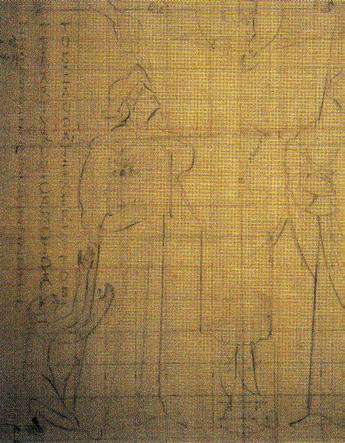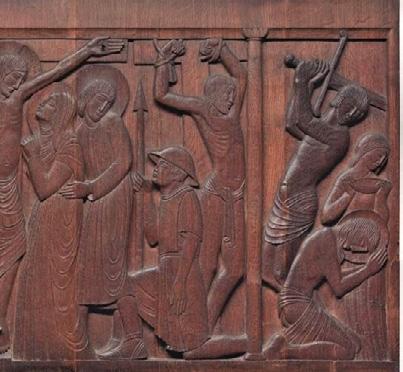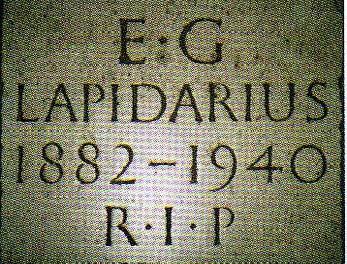
6 minute read
9 17 19
from Oremus January 2021
Eric Gill – The Final Years
Patrick Rogers
Besides his work on mosaics, Eric Gill was involved in several other Cathedral projects in the years leading up to his death in 1940, though not all were completed. The first was for a tombstone, appropriately enough since Gill had started his career as a carver of tombstones.
In 1917 Count Alexander Benckendorff, Tzar Nicholas II’s last Ambassador to Britain, had died of influenza and his daughter, the Hon Mrs Ridley, had arranged for him to be buried in St Peter’s crypt in the Cathedral, as he had requested. But his tomb was unmarked. In March 1938 Mrs Ridley set out to rectify this and the Cathedral Art Committee recommended Gill to carve the inscription. The memorial, of dark green Cumberland slate, was completed by him at a cost of
The design for a sanctuary column capital, with the uncarved capital
some £70 and placed on the tomb in early 1939. It bears the coat of arms of Count Benckendorff and the inscription, in Russian and Latin: Count Alexander Philip Constantin Ludwig Benckendorff, Ambassador Extraordinary and Plenipotentiary for Russia to the Court of St James’s. August 1 1849 – January 11 1917. Requiescat in Pace.
The next work which the committee believed Gill should undertake was in the Cathedral sanctuary. Either side of this are three columns in coloured marble, but their capitals of white carrara marble are as yet uncarved, unlike those elsewhere in the Cathedral. In May 1939 the Art Committee recommended that Gill should carve them and, for good measure, design and carve a Paschal candlestick as well. Cardinal Hinsley turned down the candlestick (thus saving an estimated £200), but agreed to the capitals. Gill’s designs, dated January 1940 and only recently rediscovered, show the Last Supper, Garden of Gethsemane, Scourging at the Pillar, Crowning with Thorns, Nailing to the Cross and Piercing with the Spear. Sadly the War and Gill’s worsening health in 1940 prevented them being executed.
The last project which Eric Gill undertook for the Cathedral was an altarpiece for the Chapel of St George and the English Martyrs. In October 1939 he produced his initial design for a carved panel of Hopton Wood limestone with Christ crucified in

© St Peter’s church, Gorleston-on-Sea The sanctuary arch at St Peter’s. In Gill’s design for the Cathedral, a chalice would have been at the centre of the arch, at St Peter’s, appropriately, it is the Apostle’s keys that are depicted. Eric Gill’s War Memorial altarpiece for Rossall School. Note the flanking images, left and right, of John the Baptist baptising Jesus and being himself beheaded in prison

The July 1939 design for the altarpiece in St George's Chapel

the centre and St Thomas More and St John Fisher (martyrs canonised in 1935) on either side. This was accepted at an estimated cost of £500. Initially he proposed that additional martyrs should be represented behind the two main figures but by July 1939, when he finalised the design, he had abandoned this idea in favour of a monkey kneeling beside More in the lower left corner, illustrating both the saint’s humanity and the lowliness of mankind. There seems to be no doubt that both Cardinal Hinsley and the Art Committee approved the design which Hinsley was reported in May 1939 ‘to have liked very much indeed’ and which was described by Gill in detail in the Cathedral Chronicle of July 1940.
© Rossall School Eric Gill’s War Memorial altarpiece for Rossall School. Note the flanking images, left and right, of John the Baptist baptising Jesus and being himself beheaded in prison
Gill worked on the altarpiece until his death in November and the final touches were added by his assistant Laurie Cribb. Because of the War it was not installed in the Cathedral until January 1947 when Cardinal Griffin, who had succeeded Hinsley in 1943, was given a private viewing. On observing the monkey he peremptorily ordered it removed. Neither Laurie Cribb, nor Eric Gill’s widow and executor, nor the Cathedral Architect in charge, nor the donors of the altarpiece (on which £100 remained to be paid) were consulted and the action was widely condemned as vandalism. The reason given for it, expressed in a letter from the Prefect of the Sacristy to the Catholic Herald in March, was that the monkey would have been only a distraction and was ‘not in accordance with the traditions of the Church’.

Addendum
It is a pity that Eric Gill’s final work in the Cathedral was vandalised in this way. Before this happened, in 1942, his widow had arranged for a small Hopton Wood stone tablet to be placed beneath the Fourteenth Station of the Cross. It reads ‘E.G. LAPIDARIUS 1882 – 1940 R.I.P. (Lapidarius being the Latin for Stoneworker).
Eric Gill’s small and inconspicuous memorial tablet at the Fourteenth Station

Fr John Scott
In his article on Eric Gill’s involvement with the Cathedral published in the November Oremus, Patrick wrote about the proposal for the sanctuary arch which the artist put forward:
‘The arch would show the Palm Sunday procession with Jesus seated on an ass on the left, an angel bearing a chalice in the centre and Jesus carrying the cross on the right. Gill explained that the scenes should be inconspicuous line drawings on a gold background – more like an inscription or arabesque than a painted picture, and should represent the two great humiliation scenes before the Crucifixion – itself represented by the great crucifix already hanging before the sanctuary in front of the proposed chalice. For: “these things are the essence of Christian teaching: He humbled himself. He rode an ass. He carried his own cross. He shed his own blood. It is a great big Church, in the midst of a great big Babylon. But it is not as a victor and as a swaggering Lord that he should appear”. But this was too radical for the Committee and Cardinal. In March 1939 Gill’s thought-provoking design for the sanctuary arch was turned down – a decision greeted with relief by Gill himself’.
That, however, is not to say that Gill judged that his idea was fundamentally flawed, for he had already brought it successfully to completion in another church, St Peter’s in Gorleston-on-Sea, Norfolk. That church, the only one designed by Gill and completed in four months during 1938, offered a very different interior to that of the Cathedral, the walls being whitewashed and the windows being of plain glass. Here we can see at least something of what Gill intended. In St Peter’s, as at the Cathedral, a great crucifix hangs in front of the arch.
The November piece also included reference to Gill carving in wood. Coincidentally, as this piece was being written, news was received that a War Memorial altarpiece, carved by Gill for Rossall School, is being put up for sale, and so the opportunity is taken here to show another example of his representation of the crucifixion.










